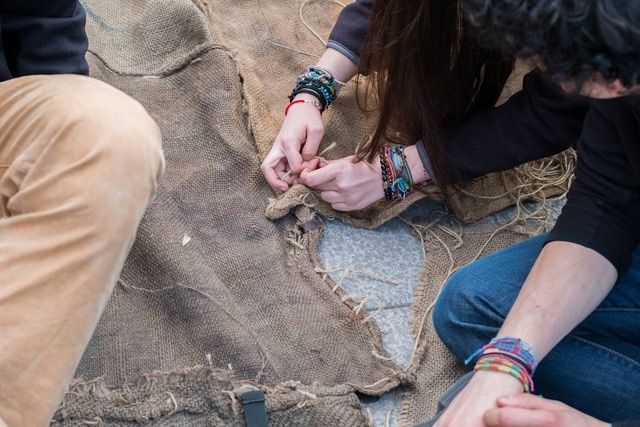The politics of spaces are determined by their forms—their architecture and infrastructures, or lack thereof—as well as by the ideas, purposes, and intentions that these forms serve. Museums, government buildings, railway stations, or residential quarters are approachable, habitable, frightening, or discomforting according to their spatial politics. These characteristics are absorbed, embodied, and emanated by the individuals who inhabit these spaces.
It is possible to disrupt and subvert the politics of spaces by granting them new forms, imposing new meanings upon them, or divesting them of their intended significance. Ibrahim Mahama’s practice of swathing buildings in fabric should be read within this framework. Born in 1987 in Tamale, Ghana, Mahama regularly envelops buildings—theaters, museums, residential buildings, ministries—in Accra and Kumasi.
The artist uses tattered jute sacks obtained from traders in exchange for new ones. The currency is memory. The sacks—made in Asia, distributed around the world, and used in Ghana to package cocoa, coffee, rice, beans, and charcoal for export to the Americas and Europe—materialize a history of global trade. They are forensic evidence in the artist’s investigation into the worldwide manifestations of the capitalist economy, but they also reveal local relations among the international working class. Those that weave, package, load, and transport them leave their sweat, names, dates, and other coordinates on the sacks. The sacks become skins with scarifications that betray their sociopolitical and economic legacies.
Mahama’s choice of jute as an artist material, draped over buildings and concealing their features, continues a long history of its use as a fabric in West Africa—for window curtains, traditional costumes, and decoration. After collecting the sacks, a group of people the artist calls “collaborators”—mostly intranational rural-urban migrants—stitch together the huge jute sculptures in a convivial atmosphere. The spaces in which this stitching is done—be it a disused railway station, a silo, or the courtyard of his parents’ house—inform the work: the sculpture takes the shape of its place of production as much as it embodies the spirit of that space. The effect is to create a new cartography of these cities, mapping and networking spaces based on the motives and purposes that Mahama concocts between them.
—Bonaventure Soh Bejeng Ndikung



